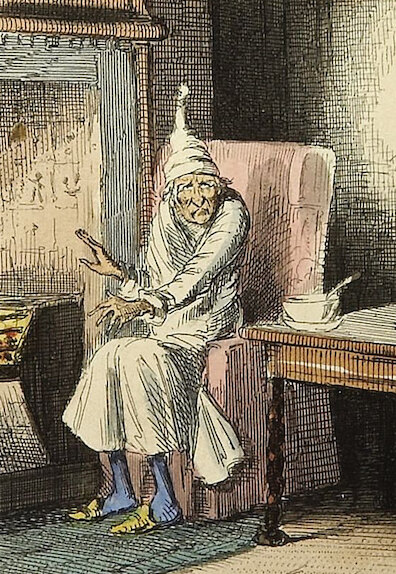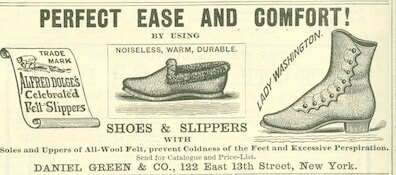Listed feet
Listed feet
In Brief
When Stephen enters Bloom's house, he follows "the man's back
and listed feet and lighted candle" down the hallway and a
short flight of stairs into the kitchen. The description of
Bloom's feet seems strange (is he leaning to one side?) only
because it employs a common 19th century usage that has since
become obsolete: "list slippers" were soled with fabric,
making them more comfortable than outdoor footwear and also
much quieter. Joyce puts them into his narrative to indicate
Bloom's solicitous care toward his possibly sleeping wife.
Read More
In a personal communication, Vincent Van Wyk notes that he
sought an obscure meaning of this word and found it on World
Wide Words (www.worldwidewords.org), a blog which Michael
Quinion compiled from 1996 until 2017. In response to a
reader's question about the meaning of "list slippers"
in Arnold Bennett's The Old Wives' Tale (1908),
Quinion reports that one meaning of "list" documented in the
OED is a border or boundary. Medieval jousting tournaments
were held in the "lists," a space defined by wooden walls
separating the warriors from the spectators. ("On pain of
death," says the marshal in Shakespeare's Richard II,
"no person be so bold / Or daring-hardy as to touch the
lists.") Pieces of fabric were similarly bordered by "lists,"
hems of selvage that prevented them from unraveling. At some
point in history, these securely woven edging materials were
adapted to serve as the soles of slippers.
Quinion observes that gunners on Royal Navy ships, as
described in C. S. Forester's Lieutenant Hornblower,
wore list slippers when handling gunpowder to lessen the risk
of sparks. But The Old Wives' Tale calls attention to
a different virtue: "Sophia wore list slippers in the morning.
It was a habit which she had formed in the Rue Lord Byron—by
accident rather than with an intention to utilize list
slippers for the effective supervision of servants." The
implication is that these cloth-soled slippers were very
quiet. Quinion quotes from an 1878 parenting manual which
prescribes that in sick rooms nurses should wear "list
slippers—soles and all being made of list," and he
observes that in Oscar Wilde's The Canterville Ghost
(1887) the poor ghost "gave up all hope of ever frightening
this rude American family, and contented himself, as a rule,
with creeping about the passages in list slippers." In
addition to the works that Quinion cites, at least one other
19th century fiction emphasizes the quietness of these
slippers: in Jane Eyre (1847) Grace Poole emerges from
the door leading to the mysterious upper story and the
protagonist sees her "glide along the gallery, her quiet
tread muffled in a list slipper."
The stealthy, soothing quietness of list slippers has clear
relevance to the passage in Ithaca. Several sentences
earlier Stephen has watched Bloom, through the kitchen window,
"removing in turn each of his two boots." This
day-ending ritual no doubt affords the paterfamilias great
relief after tramping the streets of Dublin in leather shoes
for 17 hours, but it soon becomes clear that he changes
footwear the moment he gets inside his house so as not to
awaken Molly. Honoring some kind of unnarrated guidance from
his host, Stephen takes pains to make no noise on his way from
the front steps to the kitchen: "entering softly, he
helped to close and chain the door and followed softly
along the hallway the man's back and listed feet and lighted
candle past a lighted crevice of doorway on the left and
carefully down a turning staircase of more than five steps
into the kitchen of Bloom's house."

